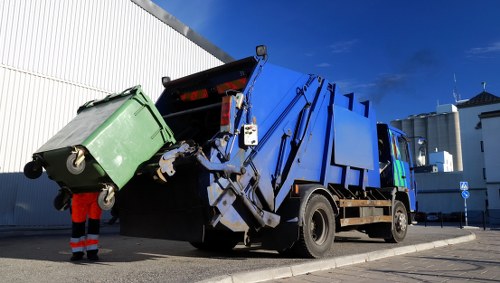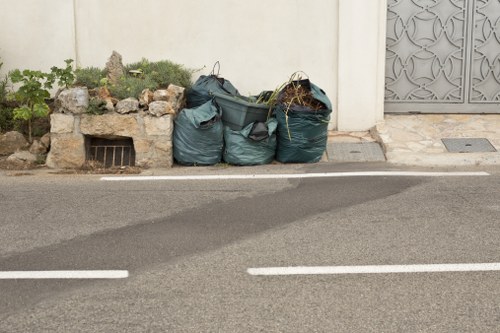Garden Clearance in Raynes Park: Transform Your Outdoor Space

Maintaining a beautiful garden requires regular upkeep, but sometimes, garden clutter can become overwhelming. Whether you’re preparing to remodel, selling your home, or simply aiming to refresh your outdoor space, garden clearance in Raynes Park is essential. This comprehensive service helps you reclaim your garden, making it a serene and enjoyable environment.
Professional garden clearance involves more than just removing unwanted plants and debris. It ensures that the cleared space is left tidy and ready for new landscaping or planting, providing a clean slate for your gardening projects. Let’s explore the benefits, process, and tips for effective garden clearance in Raynes Park.
One of the primary advantages of hiring a garden clearance service is the efficiency and expertise they bring. Professionals have the necessary tools and experience to handle large-scale cleanups quickly and safely, saving you time and effort. Additionally, they can identify and dispose of waste responsibly, adhering to local regulations and environmental standards.

Why Choose Professional Garden Clearance?
Opting for professional garden clearance services in Raynes Park offers numerous benefits that surpass DIY methods. Here are some compelling reasons to consider hiring experts:
- Expertise: Professionals understand the best practices for clearing gardens, ensuring that valuable plants and features are preserved.
- Time-Saving: What might take you days or weeks can be completed in a fraction of the time by a skilled team.
- Proper Disposal: Garden waste can be bulky and difficult to dispose of correctly. Professionals handle it efficiently, often recycling or composting where possible.
- Safety: Clearing a garden can involve heavy lifting and the use of machinery. Professionals are trained to perform these tasks safely, minimizing the risk of accidents.
Moreover, professional services can tailor their approach to your specific needs, whether you require a complete clearance or just selective removal of certain elements.
Investing in professional garden clearance not only enhances the aesthetics of your outdoor space but also increases the overall value of your property. A well-maintained garden is a significant selling point, attracting potential buyers and making a positive first impression.

Steps Involved in Garden Clearance
Understanding the process of garden clearance can help you prepare and ensure that the service meets your expectations. Here are the typical steps involved:
- Initial Assessment: Professionals begin by evaluating your garden to understand the scope of work. They identify areas that need clearance and discuss your specific requirements.
- Planning: Based on the assessment, a detailed plan is created, outlining the tasks, timeline, and resources needed. This ensures a systematic and organized approach.
- Clearing: The actual removal of unwanted plants, debris, old structures, and other elements takes place. This may involve pruning, cutting down trees, or dismantling sheds and fences.
- Debris Removal: All cleared materials are collected and transported to appropriate disposal sites. Recycling and composting are prioritized to minimize environmental impact.
- Final Cleanup: The area is thoroughly cleaned, leaving your garden tidy and ready for any subsequent landscaping or planting activities.

Preparing for Garden Clearance
Proper preparation ensures that the garden clearance process is smooth and efficient. Here are some steps you can take to prepare:
- Declutter: Remove any personal items, furniture, or garden tools that are not permanently fixed. This provides clear access for the clearing team.
- Identify Priorities: Decide which areas or elements are most important to you. Communicate these priorities to the professionals to ensure they meet your expectations.
- Clear Access: Ensure that pathways, gates, and other access points are unobstructed to facilitate the movement of machinery and personnel.
- Inform Neighbors: If the clearance work might affect neighboring properties, it’s courteous to inform them in advance.
- Discuss Special Requirements: If there are any specific instructions or preferences, discuss them with the service provider beforehand.
By taking these preparatory steps, you help the clearance team work more efficiently and reduce the likelihood of any unforeseen issues.

Post-Clearance Maintenance Tips
Once the garden clearance is complete, maintaining the new space is crucial to preserve its appeal and functionality. Here are some maintenance tips:
- Regular Weeding: Keep weeds at bay by regularly removing them. This prevents them from taking over your garden and maintains a neat appearance.
- Pruning and Trimming: Regularly prune plants and trim hedges to encourage healthy growth and keep shapes defined.
- Soil Care: Ensure the soil remains healthy by adding compost or fertilizers as needed. Healthy soil supports robust plant growth.
- Mulching: Apply mulch to retain moisture, suppress weeds, and enhance the visual appeal of your garden beds.
- Seasonal Cleanups: Conduct thorough cleanups during each season to remove fallen leaves, dead plants, and other debris.
Implementing these maintenance practices will help you enjoy a beautiful and well-maintained garden year-round.
Additionally, consider periodic inspections by professional gardeners to address any emerging issues promptly and keep your garden in optimal condition.

Eco-Friendly Garden Clearance Practices
Adopting eco-friendly practices in garden clearance not only benefits the environment but also promotes sustainable living. Here are some green practices to consider:
- Recycling Plant Waste: Instead of sending all plant materials to the landfill, recycle them by composting or using them as mulch. This reduces waste and enriches the soil.
- Selective Clearing: Preserve valuable or native plants during the clearance process. This supports local biodiversity and maintains ecological balance.
- Energy-Efficient Equipment: Use machinery and tools that are energy-efficient and have lower emissions to minimize the environmental footprint.
- Natural Pest Control: Implement natural pest control methods to manage unwanted plants and pests without relying on harmful chemicals.
- Sustainable Disposal: Partner with services that prioritize sustainable disposal methods, ensuring that waste management aligns with environmental standards.
By integrating these eco-friendly practices, you contribute to a healthier environment and foster sustainable garden management.

Cost Factors for Garden Clearance in Raynes Park
The cost of garden clearance in Raynes Park can vary based on several factors. Understanding these can help you budget effectively:
- Size of the Garden: Larger gardens require more time and resources to clear, impacting the overall cost.
- Extent of Clearance: Comprehensive clearances that involve removing structures, large trees, or extensive debris are more expensive than basic cleanups.
- Accessibility: Gardens that are difficult to access may require specialized equipment or additional labor, increasing costs.
- Waste Disposal: Proper disposal of garden waste, especially if it includes hazardous materials, can add to the expense.
- Season and Demand: Prices may fluctuate based on the time of year and the demand for services in your area.
To get an accurate estimate, it’s advisable to request quotes from multiple service providers, detailing the specific needs of your garden clearance project.
Remember, while cost is an important consideration, the quality of service and the professionalism of the team should also influence your decision.

Choosing the Right Garden Clearance Service
Selecting the right garden clearance service in Raynes Park involves careful consideration of several factors to ensure you receive quality and reliable service:
- Reputation: Research customer reviews and testimonials to gauge the reliability and quality of the service provider.
- Experience: An experienced team is more likely to handle your clearance efficiently and address any challenges that arise.
- Licensing and Insurance: Ensure that the service provider is properly licensed and insured to protect against any potential liabilities.
- Transparency: Choose a company that offers clear and detailed quotes, outlining all costs and services included.
- Sustainability: If eco-friendly practices are important to you, select a service that prioritizes sustainable clearing and waste disposal methods.
By carefully evaluating these factors, you can select a garden clearance service that meets your needs and delivers satisfactory results.
Don’t hesitate to ask for references or examples of previous projects to better understand the quality and scope of the service provider’s work.

Common Challenges in Garden Clearance
Garden clearance can come with its own set of challenges. Being aware of these can help you prepare and mitigate potential issues:
- Overgrown Vegetation: Dense and overgrown plants can be difficult to clear and may require specialized tools and techniques.
- Stubborn Debris: Removing old structures, large branches, or debris stuck in hard-to-reach areas can be time-consuming.
- Soil Conditions: Poor soil drainage or compacted earth can make the clearance process more challenging and may require additional groundwork.
- Unexpected Obstacles: Hidden utilities, roots from large trees, or other unexpected elements can complicate the clearance process.
- Weather Conditions: Rain, wind, or extreme temperatures can delay work and affect the efficiency of the clearance process.
Professional garden clearance services have the expertise to handle these challenges effectively, ensuring a smooth and successful cleanup.
By anticipating potential obstacles, you can work collaboratively with your service provider to find solutions and keep the project on track.

Benefits of a Clear Garden
A well-cleared garden offers numerous benefits, enhancing both the functionality and aesthetic appeal of your outdoor space:
- Enhanced Curb Appeal: A neat and organized garden improves the overall appearance of your property, making it more attractive to visitors and potential buyers.
- Increased Usable Space: Clearing clutter creates more space for outdoor activities, gardening, and relaxation.
- Improved Plant Health: Removing dead or diseased plants promotes healthier growth and reduces the risk of pests and diseases.
- Safety: A clutter-free garden reduces the risk of accidents, especially in areas where children or pets play.
- Environmental Benefits: Proper garden clearance can contribute to better air quality, soil health, and local biodiversity.
Investing in regular garden clearance ensures that your outdoor space remains inviting and well-maintained, providing a peaceful retreat for years to come.
Additionally, a clear garden allows for better planning and execution of landscaping projects, enabling you to realize your vision for a beautiful and functional outdoor area.

Seasonal Garden Clearance Tips
Different seasons present unique challenges and opportunities for garden clearance. Here are some seasonal tips to keep your garden in top shape:
- Spring: As plants begin to grow, perform a thorough clearance to remove any debris from winter. Prune dead branches and prepare the soil for new planting.
- Summer: Maintain your garden by regularly weeding, watering, and pruning. Clear any fallen leaves or plant matter to prevent pests.
- Autumn: Remove fallen leaves, dead plants, and other debris to prepare for the colder months. This helps prevent mold and disease.
- Winter: Clear snow, if applicable, and ensure that pathways remain accessible. Protect sensitive plants from frost and prepare tools for the next season.
Adapting your garden clearance activities to the seasons ensures that your garden remains healthy and vibrant throughout the year.
Regular seasonal maintenance also makes the overall clearance process easier, preventing the accumulation of large amounts of debris.

Tools and Equipment for Garden Clearance
Effective garden clearance requires the right tools and equipment. Professionals typically use a combination of manual and mechanical tools to ensure efficiency and thoroughness:
- Pruning Shears: For trimming and shaping plants and shrubs.
- Rakes: To collect leaves, twigs, and other debris.
- Shovels and Spades: For digging, lifting, and moving soil and plants.
- Wheelbarrows: To transport heavy materials and waste.
- Chainsaws: Essential for cutting through thick branches and large trees.
- Brush Cutters: For clearing overgrown areas and dense vegetation.
- Heavy Machinery: Such as excavators or skid steers for large-scale clearance projects.
Having access to the appropriate tools and equipment ensures that the garden clearance process is completed efficiently and to a high standard.
Additionally, using well-maintained and suitable tools reduces the risk of damage to plants and structures within your garden.

Environmental Impact of Garden Clearance
While garden clearance is necessary for maintaining order and aesthetics, it’s important to consider its environmental impact. Sustainable practices can help minimize negative effects:
- Waste Reduction: By recycling and composting garden waste, you reduce the burden on landfills and promote soil health.
- Preserving Biodiversity: Selectively clearing plants ensures that native flora and fauna are preserved, supporting local ecosystems.
- Energy Conservation: Using energy-efficient tools and machinery reduces the carbon footprint of the clearance process.
- Water Management: Properly managing cleared areas can improve water drainage and reduce erosion.
- Soil Preservation: Avoid excessive digging and soil disturbance to maintain soil structure and fertility.
By implementing environmentally friendly garden clearance practices, you contribute to the sustainability of your local environment and promote a healthier ecosystem.
Collaborating with service providers who prioritize eco-friendly methods ensures that your garden clearance aligns with your environmental values.

Legal Considerations for Garden Clearance
When undertaking garden clearance, it’s essential to be aware of local regulations and legal considerations to avoid potential issues:
- Permits: Certain clearance activities, such as removing large trees or structures, may require permits from local authorities.
- Protected Species: Be cautious of any protected plants or wildlife that may inhabit your garden. Disturbing them can lead to legal penalties.
- Waste Disposal Regulations: Ensure that garden waste is disposed of in accordance with local waste management guidelines to avoid fines or environmental harm.
- Boundary Laws: Be mindful of property boundaries when performing clearance to prevent encroachment on neighboring properties.
- Health and Safety Laws: Adhere to health and safety regulations to protect both workers and residents during the clearance process.
Staying informed about these legal aspects ensures that your garden clearance project proceeds smoothly and without legal complications.
Consulting with professionals who are knowledgeable about local regulations can help navigate these considerations effectively.

Enhancing Your Garden Post-Clearance
After a successful garden clearance, the next step is to enhance your outdoor space to make it truly remarkable. Here are some ideas to consider:
- Planting New Flora: Introduce new plants, flowers, and shrubs to add color and life to your garden.
- Adding Hardscapes: Install paths, patios, or garden walls to create structure and facilitate easy navigation.
- Water Features: Incorporate fountains, ponds, or water gardens to add a tranquil element to your space.
- Lighting: Use garden lighting to highlight key features and extend the usability of your garden into the evening.
- Seating Areas: Create comfortable seating areas where you can relax and enjoy your garden.
By thoughtfully enhancing your garden after clearance, you can create a beautiful and functional outdoor space that meets your specific needs and preferences.
Consider consulting with a landscape designer to bring your vision to life, ensuring that all elements harmonize and complement each other.

Frequently Asked Questions about Garden Clearance
To help you better understand the process and benefits of garden clearance in Raynes Park, here are answers to some frequently asked questions:
1. How long does a garden clearance take?
The duration of a garden clearance depends on the size of the garden, the extent of clearance required, and the complexity of the tasks. On average, a small to medium-sized garden can be cleared within a day, while larger or more intricate projects may take several days.
2. What does garden clearance include?
Garden clearance typically includes the removal of unwanted plants, weeds, debris, old structures, and other clutter. It may also involve pruning, trimming, and preparing the soil for future landscaping or planting.
3. Is garden clearance environmentally friendly?
Professional garden clearance services often prioritize eco-friendly practices, such as recycling plant waste, composting, and minimizing the use of harmful chemicals. Discuss your environmental preferences with the service provider to ensure sustainable clearance.
4. Do I need a permit for garden clearance?
Depending on the scope of the clearance, especially if it involves removing large trees or structures, you may need permits from local authorities. It’s advisable to check with your local council or a professional service provider to determine if permits are required.
5. How much does garden clearance cost?
The cost varies based on factors like garden size, complexity of clearance, waste disposal needs, and any additional services required. Obtaining quotes from multiple providers can help you find a service that fits your budget.
If you have more questions or need personalized advice, don’t hesitate to contact us today for a consultation.

Conclusion
Effective garden clearance in Raynes Park is a vital step in maintaining a beautiful and functional outdoor space. Whether you’re looking to revamp your garden, prepare for a sale, or simply enjoy a clutter-free environment, professional garden clearance services offer the expertise and efficiency needed to achieve your goals.
By understanding the benefits, process, and best practices of garden clearance, you can make informed decisions that enhance the beauty and value of your property. From initial assessment to post-clearance maintenance, each step plays a crucial role in transforming your garden into a serene and inviting haven.
Don’t let garden clutter hinder your outdoor enjoyment. Book your garden clearance service now and take the first step towards a revitalized and picturesque garden that you can be proud of.